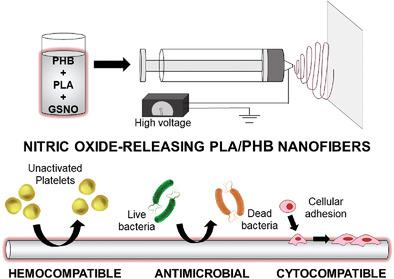当前位置:
X-MOL 学术
›
Macromol. Biosci.
›
论文详情
Our official English website, www.x-mol.net, welcomes your
feedback! (Note: you will need to create a separate account there.)
S‐Nitrosoglutathione‐Based Nitric Oxide‐Releasing Nanofibers Exhibit Dual Antimicrobial and Antithrombotic Activity for Biomedical Applications
Macromolecular Bioscience ( IF 4.4 ) Pub Date : 2020-10-05 , DOI: 10.1002/mabi.202000248 Megan Douglass 1 , Sean Hopkins 1 , Rashmi Pandey 1 , Priya Singha 1 , Megan Norman 1 , Hitesh Handa 1
Macromolecular Bioscience ( IF 4.4 ) Pub Date : 2020-10-05 , DOI: 10.1002/mabi.202000248 Megan Douglass 1 , Sean Hopkins 1 , Rashmi Pandey 1 , Priya Singha 1 , Megan Norman 1 , Hitesh Handa 1
Affiliation

|
The novel use of nanofibers as a physical barrier between blood and medical devices has allowed for modifiable, innovative surface coatings on devices ordinarily plagued by thrombosis, delayed healing, and chronic infection. In this study, the nitric oxide (NO) donor S‐nitrosoglutathione (GSNO) is blended with the biodegradable polymers polyhydroxybutyrate (PHB) and polylactic acid (PLA) for the fabrication of hemocompatible, antibacterial nanofibers tailored for blood‐contacting applications. Stress/strain behavior of different concentrations of PHB and PLA is recorded to optimize the mechanical properties of the nanofibers. Nanofibers incorporated with different concentrations of GSNO (10, 15, 20 wt%) are evaluated based on their NO‐releasing kinetics. PLA/PHB + 20 wt% GSNO nanofibers display the greatest NO release over 72 h (0.4–1.5 × 10−10 mol mg−1 min−1). NO‐releasing fibers successfully reduce viable adhered bacterial counts by ≈80% after 24 h of exposure to Staphylococcus aureus. NO‐releasing nanofibers exposed to porcine plasma reduce platelet adhesion by 64.6% compared to control nanofibers. The nanofibers are found noncytotoxic (>95% viability) toward NIH/3T3 mouse fibroblasts, and 4′,6‐diamidino‐2‐phenylindole and phalloidin staining shows that fibroblasts cultured on NO‐releasing fibers have improved cellular adhesion and functionality. Therefore, these novel NO‐releasing nanofibers provide a safe antimicrobial and hemocompatible coating for blood‐contacting medical devices.
中文翻译:

基于 S-亚硝基谷胱甘肽的释放一氧化氮的纳米纤维在生物医学应用中表现出双重抗菌和抗血栓活性
纳米纤维作为血液和医疗设备之间的物理屏障的新颖用途,使得可以在通常受到血栓形成、延迟愈合和慢性感染困扰的设备上进行可修改的创新表面涂层。在这项研究中,一氧化氮(NO)供体S-亚硝基谷胱甘肽(GSNO)与可生物降解聚合物聚羟基丁酸酯(PHB)和聚乳酸(PLA)混合,用于制造专为血液接触应用而设计的血液相容性抗菌纳米纤维。记录不同浓度的 PHB 和 PLA 的应力/应变行为,以优化纳米纤维的机械性能。根据其 NO 释放动力学评估掺有不同浓度 GSNO(10、15、20 wt%)的纳米纤维。PLA/PHB + 20 wt% GSNO 纳米纤维在 72 小时内表现出最大的 NO 释放量(0.4–1.5 × 10 -10 mol mg -1 min -1)。暴露于金黄色葡萄球菌24 小时后,释放 NO 的纤维成功地将活粘附细菌数量减少约 80% 。与对照纳米纤维相比,暴露于猪血浆中的释放 NO 的纳米纤维使血小板粘附减少了 64.6%。研究发现纳米纤维对 NIH/3T3 小鼠成纤维细胞无细胞毒性(>95% 活力),4',6-二脒基-2-苯基吲哚和鬼笔环肽染色显示,在释放 NO 的纤维上培养的成纤维细胞具有改善的细胞粘附和功能。因此,这些新型的释放 NO 的纳米纤维为血液接触医疗器械提供了安全的抗菌和血液相容性涂层。
更新日期:2020-10-05
中文翻译:

基于 S-亚硝基谷胱甘肽的释放一氧化氮的纳米纤维在生物医学应用中表现出双重抗菌和抗血栓活性
纳米纤维作为血液和医疗设备之间的物理屏障的新颖用途,使得可以在通常受到血栓形成、延迟愈合和慢性感染困扰的设备上进行可修改的创新表面涂层。在这项研究中,一氧化氮(NO)供体S-亚硝基谷胱甘肽(GSNO)与可生物降解聚合物聚羟基丁酸酯(PHB)和聚乳酸(PLA)混合,用于制造专为血液接触应用而设计的血液相容性抗菌纳米纤维。记录不同浓度的 PHB 和 PLA 的应力/应变行为,以优化纳米纤维的机械性能。根据其 NO 释放动力学评估掺有不同浓度 GSNO(10、15、20 wt%)的纳米纤维。PLA/PHB + 20 wt% GSNO 纳米纤维在 72 小时内表现出最大的 NO 释放量(0.4–1.5 × 10 -10 mol mg -1 min -1)。暴露于金黄色葡萄球菌24 小时后,释放 NO 的纤维成功地将活粘附细菌数量减少约 80% 。与对照纳米纤维相比,暴露于猪血浆中的释放 NO 的纳米纤维使血小板粘附减少了 64.6%。研究发现纳米纤维对 NIH/3T3 小鼠成纤维细胞无细胞毒性(>95% 活力),4',6-二脒基-2-苯基吲哚和鬼笔环肽染色显示,在释放 NO 的纤维上培养的成纤维细胞具有改善的细胞粘附和功能。因此,这些新型的释放 NO 的纳米纤维为血液接触医疗器械提供了安全的抗菌和血液相容性涂层。











































 京公网安备 11010802027423号
京公网安备 11010802027423号